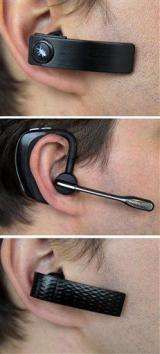Review: New headsets let you shoot the breeze

(AP) -- Bluetooth wireless headsets have become a lot better in the last few years at picking out the user's voice from noisy surroundings.
But a key problem has persisted: If you're in a breezy place, it's been hard to make yourself heard above the sound of the wind whistling over the microphone.
The latest generation of high-end headsets, with prices ranging from $100 to $130, promise to do a better job at wind suppression. I tested three of them in locales that included a windy rooftop and the streets of New York.
The most telling place for the test actually was an interior staircase that, because of some fluke of the ventilation system, has a steady, light breeze of about 5 mph. That doesn't sound like much, but it's enough for conversation to be impossible with a Motorola H350, a 3-year-old headset that's still on sale.
With today's better headsets, the stairwell breeze was noticeable, but I could still make myself heard. Outdoors in gusty weather, even the best headsets were occasionally overcome.
The contenders were:
- The $100 Voyager PRO, from Plantronics Inc. of Santa Cruz, Calif. This model is sort of a throwback, bucking the trend toward smaller headsets. Most of its bulk sits behind the ear, like a hearing aid. A long boom brings the microphone close to your mouth. That helps with the audio pickup at the price of making you look like you escaped off the bridge of the starship Enterprise. (By the way, I've thought of a way to make a detachable microphone that comes closer to the mouth, for even better sound. It attaches to the nose like a bull ring. Interested manufacturers should contact me.)
The Voyager is heavier than the other headsets, but sits comfortably on the ear. General noise suppression is excellent. Wind suppression is not that good, but the Voyager has a very smart feature that makes up for that: It connects the microphone to the earbud, so the wearer can hear when the microphone is picking up the wind. Often, just turning your head away from the wind will get rid of most of the noise, and the Voyager lets you figure out how to do that.
The Voyager yields 6 hours of talk time before needing to be recharged, compared to 4 to 4.5 hours for the other models.
- The $130 Jawbone Prime, from San Francisco-based Aliph. This company has built a reputation for making headsets with good noise cancellation. They do this by sensing vibrations in your jawbone to figure out when you're saying something.
The latest model is slimmer and has noticeably better incoming audio quality and wind suppression than the first Jawbone. But overall, the other two headsets in the test did better in the wind, and with street noise.
The user interface on the Jawbone is particularly difficult to master. For instance, you redial your last outgoing call by triple-tapping a button. Any gadget that expects me to triple-tap is overestimating my rhythmic abilities. To make it worse, this is a button that does other things if you tap it once, or if you hold it for two seconds, and it reacts differently to those actions depending on whether you're on a call or not.
- The $130 Q1 from BlueAnt Wireless Pty Ltd. of Australia. This headset looks ordinary, but hides a lot of smarts: It takes voice commands and talks to you. If you want to redial a call, you push a button and say "Redial." If you want to connect the headset to a new phone, you say "Pair me," and it walks you through the process in a patient male voice. If you can't remember the keywords, push the button and ask "What can I say?"
BlueAnt's V1, which came out last year, was the first headset with built-in voice recognition. The Q1 improves on it with a sleeker look and sharper audio quality. In fact, the Q1 did very well both in noisy environments and in the wind, despite lacking an extended boom or a jawbone sensor.
So the Q1 is my pick of the batch. The voice-controlled interface alone makes it stand out, and the audio performance makes it even more attractive. Like other headsets, it works with Bluetooth-equipped phones from any wireless carrier. Unfortunately, the Q1 is sold only through Sprint stores until about June 7, when it will be available in other stores and online.
However, either of the other headsets will make a nice upgrade from earlier models, if your voice gets lost in the wind.
---
On the Net:
©2009 The Associated Press. All rights reserved. This material may not be published, broadcast, rewritten or redistributed.
















